This is the second article about how I grow my own collection. In the first covered growing indoor plants with hydroponics. Now I’ll talk about how I grow the rest of my tradescantias with more conventional methods.
As National Collection Holder, I have to keep three duplicates of every plant. One of those sets of grows indoors, but this article will be about both the other two sets. Although they are in different places, a lot of their care is similar so it’s more useful to group them together here.
Environmental conditions
Porch
One set lives in my large porch/conservatory. It’s unheated, uninsulated, has windows on all sides and a clear polycarbonate roof – so it’s really like a greenhouse. It faces Southwest and gets direct sun for most of the day. The plants are on stacked shelves, so the ones on lower levels are partly shaded from above.
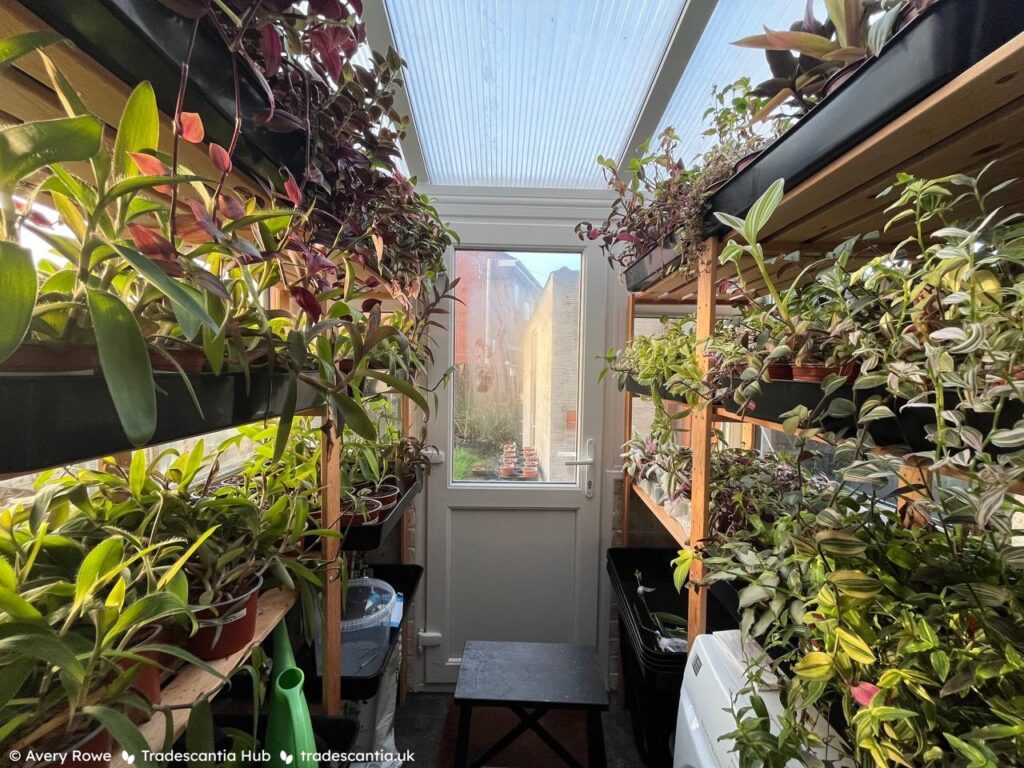
The combination of windows and no heating means that it has very extreme temperature swings. During summer it often reaches 35ºC on sunny days, but can still drop to 10-15ºC overnight. I often open the door and windows in warm weather which gets the air moving a lot. In winter it doesn’t get above 10-15ºC in the day, and at night it drops to below 5ºC but not below freezing. The humidity ranges quite widely, but is almost always above 50%.
Outside
The other set of plants live outside, on shelves on my Southwest-facing patio in Wales, UK. Some of the shelves are angled directly to the Southwest, and some more to the Southeast, but they all get direct sun for most of the day. The plants at the back of the lower shelves are slightly shaded.
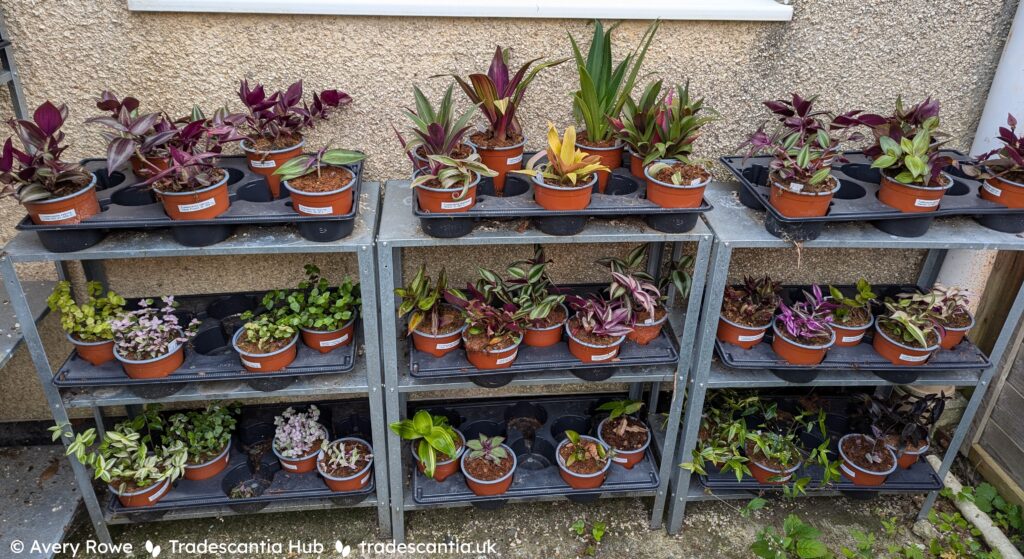
During summer, they’re fully exposed to the weather. The climate here is mild, so summer highs are usually 25-30ºC at the most, and don’t last long. We get a lot of rain all year round, and the humidity rarely gets below 50%.
Our winters are mild too, with overnight lows rarely getting below -5ºC, and daytimes usually above freezing. In winter 2023-24, I left the outdoor plants completely unprotected to monitor what would happen. At the first frost, all the T. zebrina were destroyed, but most other species survived. Over the whole winter though, almost all of them eventually rotted away. I suspect that the problem was the combination of wet and cold, rather than the temperatures themselves. So in winter 2024/25, I’m planning to cover the shelves just to keep them dry, and see if that helps them survive the cold better.
Containers and potting mix
Each plant lives in a 12cm, 0.5-litre recycled plastic pot with drainage holes at the bottom. I use the same containers indoors and out. I make my own potting mix, from a very simple combination of two-thirds coir pith and one-third fine (2-7mm) pine bark chips, amended with controlled-release fertiliser pellets that last a year.
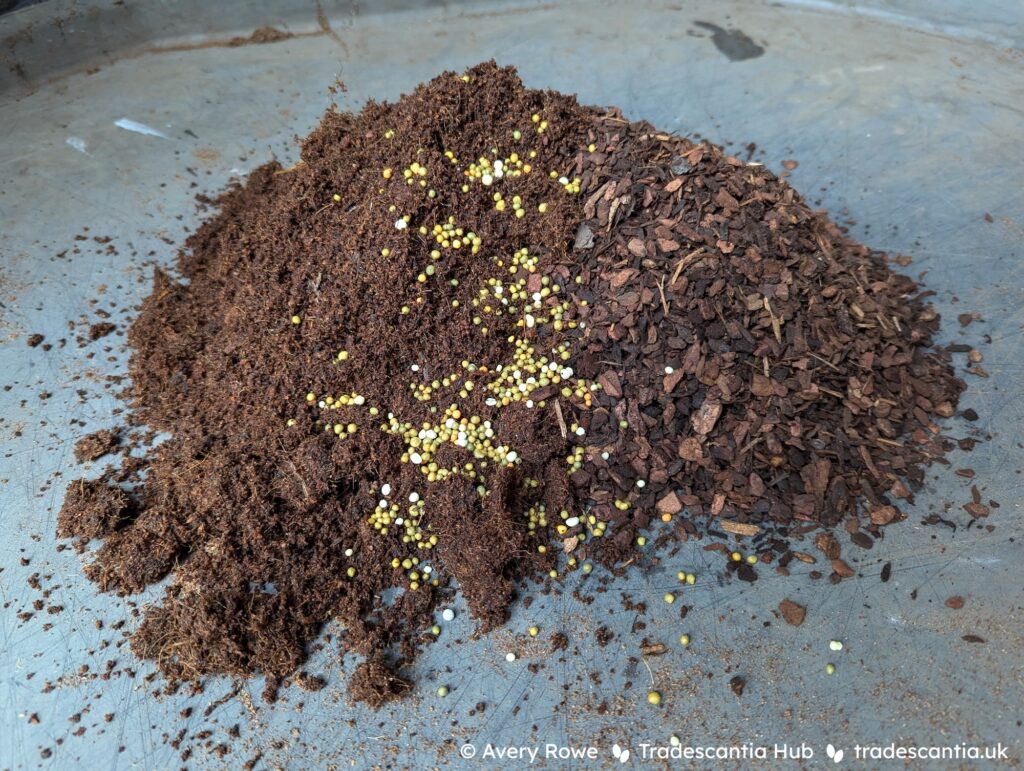
Coir pith is a fluffy lightweight substance which holds onto water and nutrients for the roots to access, as a renewable alternative to peat. Bark chips are larger particles which create more air gaps in the mix, to keep the roots from being waterlogged. Controlled-release fertiliser pellets are little beads filled with fertiliser and precisely tuned to let the nutrients out gradually over a specific period of time.
I don’t think there’s anything really special about my potting mix. I’ve used other materials in the past, and the reasons for settling on my current recipe are pretty specific to my situation. My space is limited, so I like the fact that coir is sold in dried compressed bricks. I’ve tried perlite for air gaps before, and I was irritated by the way it floats to the top of the mix and blows away. Organic nutrient sources like compost are unpredictable and inconsistent, which makes it difficult for me to monitor the health of the whole collection. And the overall level of water retention that works for my plants is determined by my climate and my own watering routines.
Anyone else might make completely different choices about how to pot the same plants, and there’s no right or wrong options. So I wouldn’t specifically recommend my potting mix, other than as a starting point to experiment with and adjust to suit your own needs.
Watering
Porch
The porch plants sit in deep watertight trays on their shelves. I use collected rainwater as much as possible, but sometimes have to resort to the hose. I pour water over the top of the plants and the tray, until it fills up to around 5mm deep at the bottom. Before I started using trays like this, I found that if I forgot to water for a little bit too long the soil would become too hydrophobic to absorb water again, and the plants ended up chronically dehydrated.
I wait until the soil is completely dry and the pots feel light before watering again. This varies from a few days in a summer heatwave, to many months over winter.
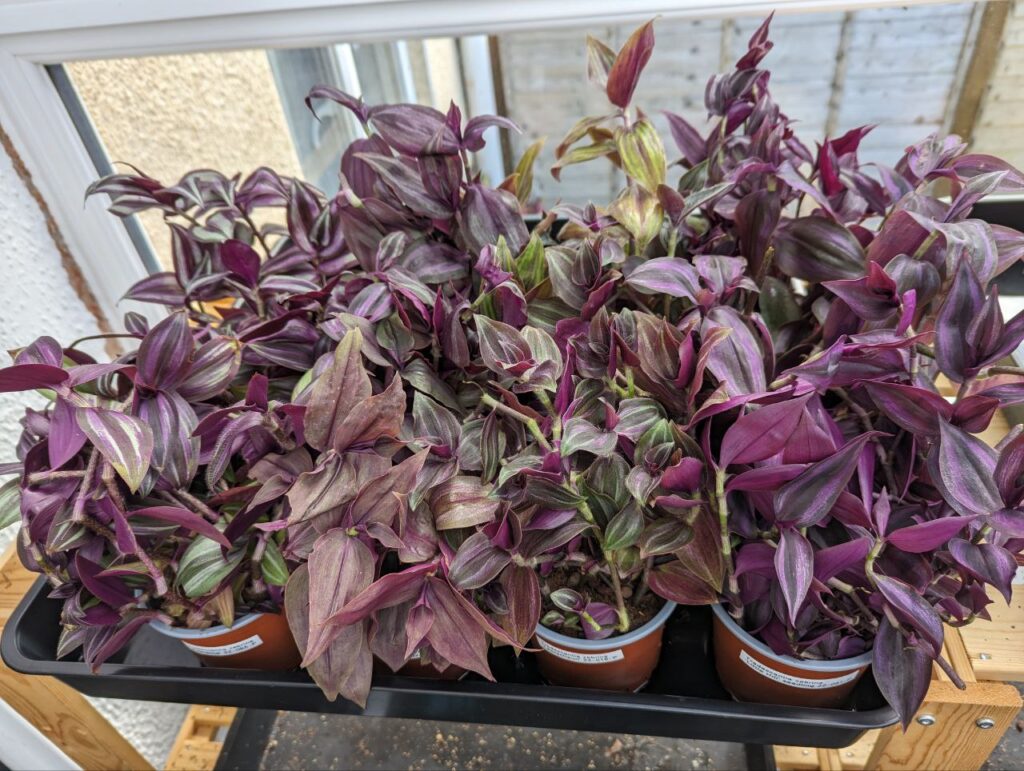
Outside
The outdoor plants sit in transport trays which stop them being blown over in the wind, but the trays have drainage holes and don’t hold onto water.
The plants on the top shelves are completely exposed to all of our (frequent!) rain, and only need supplemental water in dry spells. The lower shelves get some run-off but not as much, so I still have to water them regularly.
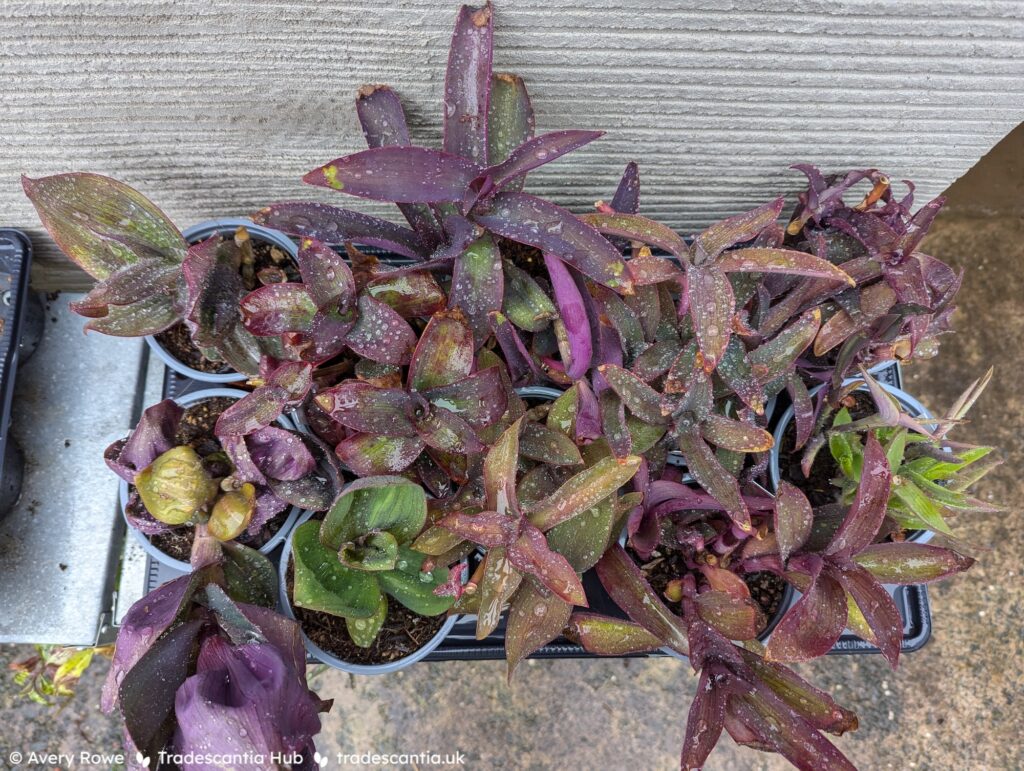
Again I use collected rainwater if I can, or sometimes the hose. I pour water generously over the top of the plants, until it runs out from the bottom. I usually water all the plants, and then go back to the start and water them all again – to make sure that any hydrophobic soil gets a chance to properly rehydrate.
Long-term maintenance
The slow-release fertiliser only provides nutrients for a year. I prune and propagate the plants regularly to keep them under control, but eventually their roots fill the pot and they can’t absorb enough water to stay hydrated. So I repot everything once a year, in spring.
- I collect up both the porch and outdoor pots of each cultivar, and do them together.
- I cut all the healthy growing ends from each and set them aside.
- I take the rootball out of the pot and shake off any loose soil – I save that to reuse.
- I discard the rest of the roots and bare lower stems.
- I add new fertiliser to the reused soil, combine it with fresh mix if needed, and fill both pots with it.
- I divide the cuttings and stick half of them into the middle of each pot.
- I water straight away to settle the soil in around the stems.
Here’s a video I posted on instagram showing my repotting process:
Conclusions
A lot of people worry about whether tradescantias can go outside because they’re “houseplants” in temperate climates. But in fact my outdoor and porch plants always end up growing bigger, stronger, and more attractive than the indoor ones. The bright sun and temperature variation brings out their more succulent habit, which makes them compact, hardy, and very brightly coloured.
Although being outside means they’re more accessible to pests, they actually have far fewer infestations than indoor plants. Being more accessible to pests also means being more accessible to pest-predators and other natural population controls, so they almost never get out of hand enough to cause problems. They get more ripped and damaged leaves than indoor plants, but not enough to do any harm or make them look unattractive.
Durnig the winter, the porch plants go pretty much dormant. I stop watering and let them dry out, which prevents them from rotting. That combination of cool and dry slows their growth to almost nothing, which makes them low-maintenance but also not as rewarding as indoor plants that keep going through winter.
I’m still experimenting with overwintering the outdoor plants. Because I have duplicates of the whole collection, I can afford to try things out and refresh any that died in the following spring. My theory is that finding a way to keep them dry will allow them to survive much lower temperatures – in the same as other succulents and cacti can cope with deep freezes if they’re dry.
For anyone in a temperate climate, I’d recommend trying tradescantias outdoors at least for the summer. They don’t need any more maintenance than they do indoors, and it’s rewarding to see how bright and compact they become under ideal conditions.


4 replies on “How I grow my outdoor tradescantias”
Really interesting thank you!! My only question would be regarding disposal of the rootball – is this because they’d become too big & unmanageable or that the plant has a shorter natural lifespan so this is the best way to have a healthy plant?
It’s basically just because the roots and lower stems become awkward to deal with when they’re very overgrown. The densely-packed roots compact the soil which stops it from absorbing water, and the lower stems form a mat over the surface that makes it difficult to propagate new stems. It would be perfectly possible to carefully pick apart all of the stems, clear off the soil from all of the roots, and then repot them all separately. But I don’t find it worth the effort when it’s so easy to propagate the stem ends (with the bonus that they already have attractive leaves to begin with).
My tradescantia is outside in a flower pot but is not growing nor flowering, kindly advise.
What is the climate like in your location? If it’s winter, growth will slow down a lot.